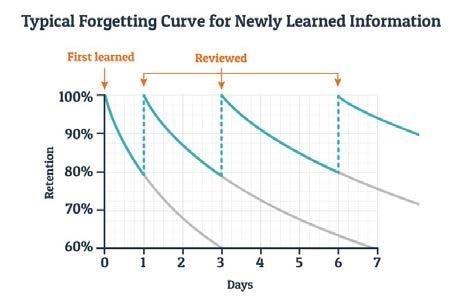
3 minute read
Learning and Memory
This focus on memory sits within the field of cognitive science as Dylan Wiliam argues Cognitive Load Theory (CLT) is;
— 2017
We should be planning teaching in line with how the human brain works. This theory supports teaching, building and regularly revisiting knowledge as the vital building block in gaining subject expertise and reaching deeper understanding.
‘We need to acknowledge that high level critical thinking is only possible when important knowledge and understanding has been committed to long-term memory. Memorisation is not the enemy of critical thinking and creativity, as some have suggested, it is the platform and scaffolding which is required to enable it to happen’ (‘Looking to the Future without Trashing the Past’ - Tim Oates CBE, Director of Assessment Research and Development at Cambridge Assessment. CST 2021).
Classroom teaching should consider the detrimental effects of overloading processing power in the working memory. Link to prior knowledge, present material in chunked steps, check understanding regularly. Avoid split attention, for example speaking whilst students are trying to read, strategies such as dual coding (combining words and visuals) are recommended as advocated by Caviglioli.
Daniel Willingham explains the importance of embedding critical knowledge in long term memory:
1. You can only think deeply and critically about what you know well— i.e. that which you have a lot of knowledge about.
2. To aid thinking, that knowledge must be encoded in long-term memory.
Retrieval practice is the tool that encodes knowledge in long term memory. Having to recall something - especially having to struggle to recall it after a bit of forgetting has begun strengthens the neural pathway in which it is encoded making it stronger and easier to recall.
In line with Dunlosky’s Strengthening the Student Toolkit we advocate four central strategies to encourage knowledge retention:
1. Self Quizzing and Practice Testing: Low stakes testing, clear knowledge based tests.
These should be incorporated into lessons and our students are also trained to develop hard working self-quizzing techniques.
Full recall (rather than simply spotting the right answer) is the best for promoting retrieval rather than multiple choice which are more suited as hinge questions to elicit misconceptions. There is also a benefit in getting the answer wrong - for those answers completed with a high level of confidence which are then shown to be wrong a ‘hypercorrection effect occurs, that is, the correct answer ‘sticks’ for longer (Butterfield and Metcalfe 2001).
2. Distributed Practice: Recap or teach over several days rather than cramming – it allows students to forget and relearn so promotes effective long term retention. We work practice into remote learning to revisit and repeat content in practice testing to reinforce retention.

The Ebbinghaus Forgetting Curve exemplifies this strategy 3. Interleaved practice: It is important to space out and revisit topics. If students simply do massed practice on one topic they will seem fluent in it but this is short term and quickly forgotten. It is the same strategy as learning spellings in primary school – learn each and then cycle through them all over time.
Lesson starter activities which check current knowledge and knowledge from previous topics are an effective way to interleave.

4. Elaborative Interrogation and Self
Explanation: Encourage students to ask why something is so (for example photosynthesis); can they see similarities with other processes. This gives active processing of content rather than rote learning and so will be reinforced in long term memory. This is ‘Germane Cognitive
Load’ or the struggle zone which deepens understanding.



